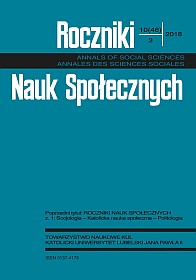Loser Candidates in the Presidential Election Campaign in 2015: Coverage in Wiadomości TVP
Abstract
In contemporary democratic state media performs many important roles. There is very important relationship between knowledge about candidates, evaluation of candidates, decision about voting and candidate coverage in media. The television is still very important source of political information. The article presents the results of media content analysis of Wiadomości TVP1 before presidential election in 2015 in Poland. The study concerns all candidates who lost in the first round of elections. There was visibility of candidates and media’s favorability examined in the analysis of the most watched TV news program. The analysis shows that the loser candidates are less visible in the program. In addition, Wiadomości TVP1 clearly indicates the low chance of winning the loser candidates.
References
Berelson B., Content Analysis in Communication Research, New York: The Free Press 1952.
Esser F., Strömbäck J., De Vreese C.H., Reviewing Key Concepts in Research on Political News Journalism: Conceptualizations, Operationalizations, and Propositions for Future Fesearch, „Journalism” 13 (2011), nr 2.
Hopmann D.N., Van Aelst P., Legnante G., Political Balance in the News: A Review of Concepts, Operationalizations and Key Findings, „Journalism” 13(2011), nr 2.
Klepka R., Bezpieczeństwo jako temat prezydenckiej i parlamentarnej kampanii wyborczej w relacjach Wiadomości TVP, w: Współczesne problemy bezpieczeństwa państwa, red. O. Wasiuta, P. Mazur, Stalowa Wola: Katolicki Uniwersytet Lubelski Jana Pawła II 2017.
Krippendorff K., Content Analysis: An Introduction to Its Methodology, Thousand Oaks, London –New Delhi: Sage Publications 2004.
Kurdupski M., „Teleexpress” zyskał 360 tys. oglądających. „Fakty” i „Wiadomości” straciły widzów, http://www.wirtualnemedia.pl/artykul/teleexpress-zyskal-360-tys-ogladajacych-fakty-i-wiado mosci-stracily-widzow (dostęp: 21.09.2016).
Kurdupski M., „Wiadomości” liderem, mimo utraty 200 tys. widzów. „Fakty” straciły w TVN 400 tys. oglądających, http://www.wirtualnemedia.pl/artykul/wiadomosci-liderem-mimo-utraty-200-tys-widzow-fakty-stracily-w-tvn-400-tys-ogladajacych (dostęp: 21.09.2016).
Kurdupski M., „Wiadomości” na czele dzienników w marcu. „Wydarzenia” straciły najwięcej, http:// www.wirtualnemedia.pl/artykul/wiadomosci-na-czele-dziennikow-w-marcu-wydarzenia-stracily-najwiecej (dostęp: 21.09.2016).
Lange B. P., Media and Elections: Some Reflections and Recommendations, w: The Media and Elections: A Handbook and Comparative Study, red. B.P. Lange, D. Ward, Mahwah–New Jersey–London: Lawrence Erlbaum Associates 2004.
Lisowska-Magdziarz M., Analiza zawartości mediów. Przewodnik dla studentów: wersja 1.1, Kraków: Uniwersytet Jagielloński 2004.
Meyen M., Thieroff M., Strenger S., Mass Media Logic and the Mediatization of Politics, „Journalism Studies” 15(2014), nr 3.
Raport z badań TNS OBOP: Wiarygodne informacje – czy są dziś w cenie?, http://www.tnsglobal.pl/wp-content/blogs.dir/9/files/2016/05/K.023_Wiarygodne_informacje_O03a-16.pdf (dostęp: 1.02.2017).
Richardson J.E., Analysing Newspapers: An Approach from Critical Discourse Analysis, Houndmills–Basingstoke–Hampshire–New York: Palgrave Macmillan 2007.
Riffe D., Lacy S., Fico F.G., Analyzing Media Messages: Using Quantitative Content Analysis in Research, Mahwah, New Jersey, London: Lawrence Erlbaum Associates 2005.
Text Analysis for the Social Sciences: Methods for Drawing Statistical Inferences from Texts and Transcripts, Mahwah, New Jersey: Lawrence Erlbaum Associates 1997.
Schoenbach K., De Ridder J., Lauf E., Politicians on TV News: Getting Attention in Dutch and German Election Campaigns, „European Journal of Political Research” 39(2001), nr 4.
Sheafer T., How to Evaluate It: The Role of Story-Evaluative Tone in Agenda Setting and Priming, „Journal of Communication” 57 (2007), nr 1.
Shehata A., Strömbäck J., Mediation of Political Realities: Media as Crucial Sources of Information, w: Mediatization of Politics: Understanding the Transformation of Western Democracies, red. F. Esser, J. Strömbäck, Basingstoke: Palgrave Macmillan 2014.
Copyright (c) 2018 Roczniki Nauk Społecznych

This work is licensed under a Creative Commons Attribution-NonCommercial-NoDerivatives 4.0 International License.


